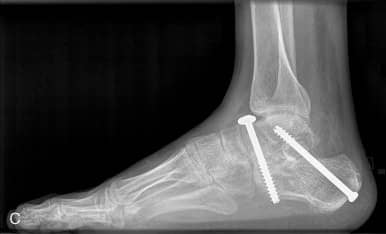Ankle Fusion Surgery - Arthrodesis
What is a Ankle Fusion Surgery?
Ankle Fusion Surgery, also referred to as Arthrodesis involves fusing the tibia (shinbone) and talus (foot bone).
Although the operation provides pain relief, it eliminates the movement of the ankle. Arthrodesis offers permanent relief from pain, does not lead to instability
Ankle Fusion surgery is performed to relieve pain in the ankle joint by surgically eliminating the joint movement and fusing two or more of the ankle joint bones together.
What Does Ankle Fusion Surgery Treat
The surgery is commonly performed to treat ankle arthritis to stop swelling, pain and inflammation and to improve ankle stability.
Severe Ankle pain can be associated with
- Osteoarthritis, caused by wear and tear over time
- Rheumatoid Arthritis, caused by an autoimmune disease that affects the joints
- Arthritis due to previous injury of your joint
Indications of Ankle Arthrodesis
Ankle Arthrodesis is recommended for the treatment for end-stage arthritis that has not responded to conservative treatment measures such as medications or injections.
Other indications for Ankle Arthrodesis include
- Ankle infections,
- Neurological ankle instability and
Benefits of Ankle Fusion Surgery
Arthrodesis offers
- permanent relief from pain,
- does not lead to instability,
- has a low risk of infection and costs less
Preparation for Ankle Fusion Surgery Surgery
Once you and the doctor have decided that surgery is required, preparation is necessary to achieve the best results and a quick and problem free recovery.
- Smoking - Stop or cut down smoking to reduce your surgery risks and improve your recovery
- Weight - Consider losing weight (if overweight) before surgery
- Medications - Refrain from taking medications or dietary supplements that may increase your risk of bleeding - refer Medication Information
- Loose Clothing - If you're having surgery, wear loose, comfortable clothing, such as baggy gym shorts and slip-on shoes, so you can easily undress and dress.
Returning Home After Surgery
When you go home you need to take special precautions around the house to make sure it is safe. Your post operative plans should include:
- Mobility or Stability - changes (rails in your bathroom, ramps for stairs)
- Sleeping - modify your sleeping arrangements (especially if you are sleeping upstairs) for easy access
- Access - ensure you have easy access to food, water, medications and any other essentials
- Showering - will be allowed once the wound is healed, or as indicated
Assess your home situation to ensure you have adequate home support in the first few weeks following surgery. If you live alone it may be necessary to arrange a package of community care to help during the first few weeks at home.
Ankle Fusion Surgery Process
How Risks Are Minimised
Get Moving Quickly
Early mobilisation is a major preventive measure. We strongly encourage you to get moving and out of bed as soon as possible after the operation to restore normal blood flow in the legs.
You should aim to do at least ten short walks (of between 2 and 5 minutes) each day in the first two weeks after surgery.
How Can I Minimise Post Operative Complications
Blood clots (DVT or PE)
All patients receive a number of treatment measures to reduce the risk of blood clots. These include
- Injections of heparin during and after surgery,
- Sequential calf compression device (SCD) whilst on the operating table, and
- Special leg stockings (TEDS)
Any patient who is at high risk of a blood clot (such as a history of blood clots or clotting disorders) may be asked to continue heparin (Clexane) injections for 30 days after the surgery in addition to the other measures. This can be done at home, and we will show you how.






